On garden plots, raisins are increasingly found. For many lovers of sunny berries, the complete or almost absolute absence of seeds in berries is a huge advantage over table grapes. Moreover, new varieties of raisins are constantly appearing, which can be grown in regions with cold winters. And although the dictionaries interpret the word borrowed from Persian "kishmish" as "small sweet seedless grapes and raisins from it", I want to argue with them. Varieties of modern breeding give rather large seedless berries, from which excellent raisins are really obtained. An example would be the Jupiter variety.
Content
An American who is not afraid of Russian winters
Kishmishnye grapes have been known for a long time. They appeared in Central Asia as a result of natural mutation. This quality was reinforced by people in new varieties. The grape raisins Jupiter is one of them. It appeared relatively recently. It was taken out in 1998 in the United States at the University of Arkansas. The aborigine of the American continent Vitis labrusca, who passed on his specific taste and aroma to the heir, and Vitis vinifera took part in its creation.
Medium-sized Jupiter grape bushes that do not freeze in severe frosts give fruits ripening very early.
The flowers of Jupiter grapes are bisexual, so it perfectly pollinates itself and can be an excellent pollinator for other varieties. Despite the significant number of inflorescences formed on the shoots, with proper care, rationing is not required, the bush copes with the load.
Its medium size, and sometimes quite large, clusters have the shape of a cylinder with a wing, converging to a cone. They are so loose that the berries do not crack when ripe.
The oval-shaped Jupiter berries are large enough. When ripe, they first gain a pink or red color, and eventually become dark blue. They are sweet, have a nutmeg aroma derived from labrusca, complemented by hints of black currant and strawberry. The skin of the berries is dense, so wasps do not damage them.
Jupiter's harvest is stable, well transported. The bunches can be stored for a long time, but they must be removed from the vines in time, otherwise the overripe berries will quickly crumble.
The Jupiter grape variety is resistant not only to winter frosts, but also tolerates spring frosts without problems. It can be grown in non-sheltering culture in many localities.
The variety is advertised as having moderate resistance to fungal diseases in grapes, but viticulture practitioners say that in many cases it does not need to be treated with fungicides at all.
Kishmish varieties Jupiter - video
Characteristics of the variety - table
| Ripening terms | from 105 to 125 days depending on the place of cultivation |
| The beginning of the fruiting of the seedling | II-III year from the time of planting |
| The number of fruitful shoots | 80% |
| Ripening vines | 96% of shoot length |
| Number of inflorescences on the shoot | from 2 to 5 |
| Average bunch weight | from 200 to 500 grams |
| Average berry weight | 4 to 7 grams |
| Seedless class | I, very rarely II, when seed rudiments are found in berries |
| Sugar content | up to 20-22% |
| The amount of acid in a liter of juice | 4-7 grams |
| Harvest per hectare | 20-26 tons |
| Productivity of an adult bush | 30-50 kg |
| Frost resistance | -27 ° С, according to some reports - up to -30 ° С |
Jupiter is easy to grow
Planting Jupiter grapes is no different from planting other varieties. You can use seedlings or grown layers from a fruiting bush. In advance, at least two weeks before planting the plant, a planting pit is prepared. Since Jupiter has an average vigor of growth, when planting several bushes, the distance between them is from two to four meters. If grapes are planted near a building, the distance to the foundation should be at least 0.7 meters.
The planting pit should be in the form of a cube with a side of 0.8-1 meter. The pit is recommended to be filled in layers:
- crushed stone - 5–10 cm;
- fertile soil - about 10 cm;
- humus - 2-3 buckets;
- fertile soil - 10 cm.
The last three layers are thoroughly mixed, and the pit is filled to the top with fertile soil.
After the soil settles well, a support stake is installed in the pit, grapes are planted, the soil is compacted, and the plant is watered abundantly, the earth is mulched with organic matter - peat, sawdust, straw, cut grass or other materials. It is important to water abundantly in the next three days after planting, then the plant is watered moderately.
Some features of growing Jupiter grapes are as follows:
- Before flowering and during the formation of berries, the plant must be watered. In hot weather, the soil is not allowed to dry out. Jupiter generally likes abundant watering.
- The ground under the grapes must be mulched with a layer of at least 3 cm with rotted sawdust, moss or humus.
- Young bushes of Jupiter, despite the frost resistance of the variety, require shelter for the winter. Mature vines do not need such protection.
- With the obligatory autumn pruning of grapes, 6–8 eyes are left on each shoot. This guarantees a harvest even if some of the buds freeze.
- Jupiter is fed regularly. Organic fertilizers are applied every three years, inorganic fertilizers are applied three times a season in accordance with the instructions for their use. *
- Despite the good resistance of Jupiter to diseases and pests, it is sprayed three times a season with available fungicides and insecticides in accordance with the instructions for their use.
* The procedure for applying inorganic fertilizers is as follows:
- before bud break - substances containing the maximum amount of nitrogen to stimulate plant growth;
- during the flowering period - preparations containing not only nitrogen, but also phosphorus (nitrophoska and others);
- after harvest - fertilizers with a high potassium content, which will accelerate the ripening of the wood and improve the readiness of the grapes for the winter cold.
For comparison with Jupiter, let's take the most popular varieties of its fellows. It is best to compare the advantages and disadvantages of different varieties of raisins, summarizing their main characteristics in a table *.
Kishmish competition - table
| Variety name | Jupiter | Radiant* | Kishmish No. 342 (Hungarian) | Sofia | Veles |
| The power of growth | medium-sized | vigorous | vigorous | vigorous | vigorous |
| Ripening terms | 105–125 | 125–130 | 110–115 | 110–120 | 100–105 |
| The number of fruitful shoots | 80% | 50–70% | 70–80% | ||
| Average bunch weight | 200-500 g | 400 g | 300-500 g | 400-600 g | 500-900 g |
| Average berry weight | 4-7 g | 2.5-4 g | 2-3.5 g | 5-7 g | 4.5-5 g |
| Seedless class | I, very rarely II | III-IV | III | I-II *** | III -IV |
| Sugar content | 20–22% | 20,2% | 19–21% | ||
| The amount of acid in a liter of juice | 4-7 g | 6,7 g | 6-8 g | ||
| Harvest per hectare | 20-25 tons | 12.6 tons | |||
| Bush harvest | 30-50 kg | 20-25 kg | 10-15 kg | ||
| Frost resistance | -27-30 ° С | -18 ° C | -24-26 ° C | -21 ° C | -21 ° C |
| Transportability | good | good | good | ||
| Disease resistance | at the level of complex resistant varieties | below standard | 2.5-3 points | 3.5-4 points | average (3.5 points) |
* For the domestic variety Kishmish Radiant, included in the state register, the data are given from there, for other varieties and forms - according to information on the Internet. If the column is not filled in, then the corresponding information was not found.
** Demanding to comply with agricultural techniques and experience of the grower.
*** Large berries contain 1-2 seeds.
From the collected data, we can conclude that it was not possible to identify the sole leader among the kishmish. At the same time, it should be noted that the information circulating on the network often has a somewhat advertising character with overestimation of some parameters of a particular sort (form), for which there is no official information.
It can be emphasized that the Jupiter variety we are considering has a number of advantages over its brethren:
- only Veles is slightly inferior to early maturity;
- only Sophia can compare with him in the size of berries;
- in the class of seedlessness, sugar content of berries and less acid in them, yield and frost resistance, Jupiter surpasses popular varieties of raisins.
The disadvantages of Jupiter raisins include:
- its average resistance to diseases, therefore, the need for preventive fungicide treatments;
- commercial use of gibberellins to increase berry size;
- the need for abundant watering until the berries ripen.
Photo gallery: varieties of raisins, taken for comparison
- Kishmish 342 (Hungarian)
- Kishmish Radiant
- Kishmish Sofia
- Kishmish Jupiter
- Kishmish Veles
Winegrowers' reviews about raisins Yubileiny
Today, Jupiter surprises me in a good way, a one-year-old seedling overwintered without shelter for the winter at -30, although it was covered with snow, many other varieties could not stand this. And what is most interesting today is that it has completely open buds with leaves, that all other varieties are at least a week behind.
Exactly that the taste is rich is the right word. Something difficult, of course with nutmeg. The skin is only dense. If you do not plan to transport Jupiter over long distances with subsequent sale, but grow it for your own needs, then leave the clusters on the bush until they wither slightly. The taste will become even richer and the skin less noticeable.
At last year's vaccination this year, more than 2 dozen inflorescences were tied on the two abandoned vines. With two-round treatment, it stood and still stands normally. Flowering began earlier than everyone else, and almost before everyone else, the color of berries began. It was fully ripe at the end of July. There is a lot of sugar with such gorgeous taste, with a rather pronounced nutmeg that the grandson who is 2 years old, among the huge berries of Leah, Transfiguration and other large-berry varieties that ripened a little later, only Jupiter USA chose raisins. The berries are pink-violet in the shape of the Radiant, but slightly larger. I got it from a friend, unfortunately he is no longer there, but his daughter brought him from America. Photo is avaiable. Not on the bush for a long time. I can't show it now. I do not know how! Yes, I forgot. Bunches are small gr 300-350. But this is the first harvest!
Luxurious raisins (American, not Hungarian, of course). The taste is delicious. Station wagon. They will try it at the market - they immediately take both berries and seedlings. I didn't make the wine myself, they say it turns out very tasty (thanks to the isable tones). High disease resistance. I cover it myself, like my entire vineyard, but I form a sleeve to winter without shelter in a combined formation (as the Soviet books bequeathed to the Rostov region). Part of the bush is covered, and part is not. There we will experience true frost resistance.
From all that has been said, we can conclude that the Jupiter variety of raisins is generally attractive for cultivation in very large areas, due to its frost resistance. You need to take care of him and adhere to the agricultural technology of growing grapes no more than for any other variety.
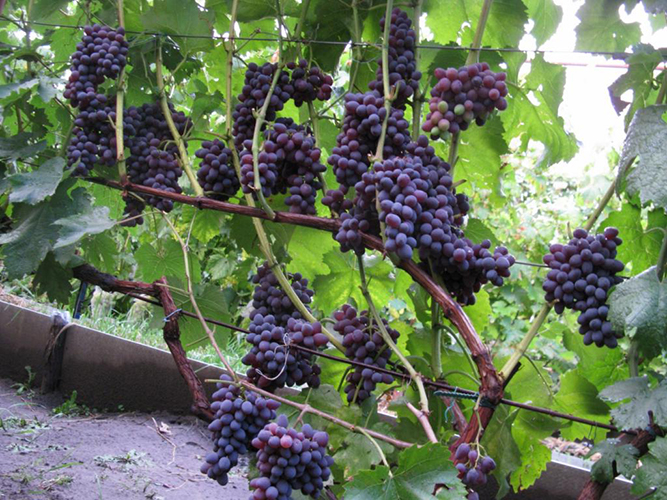
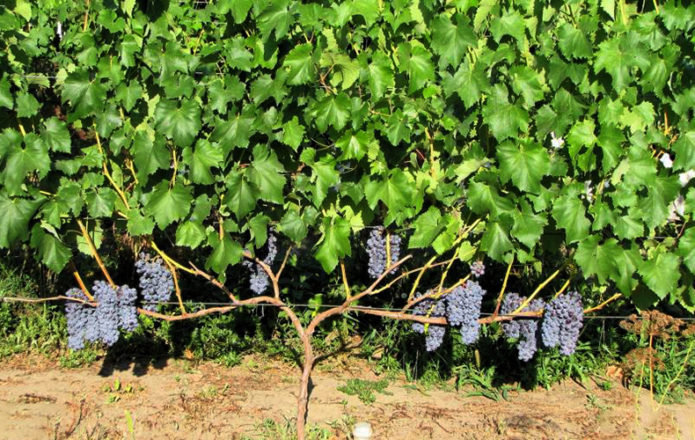
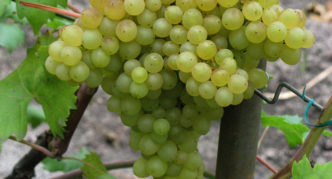

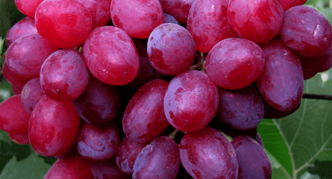

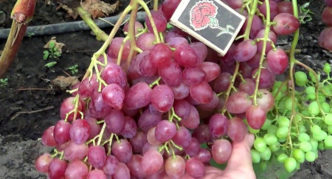


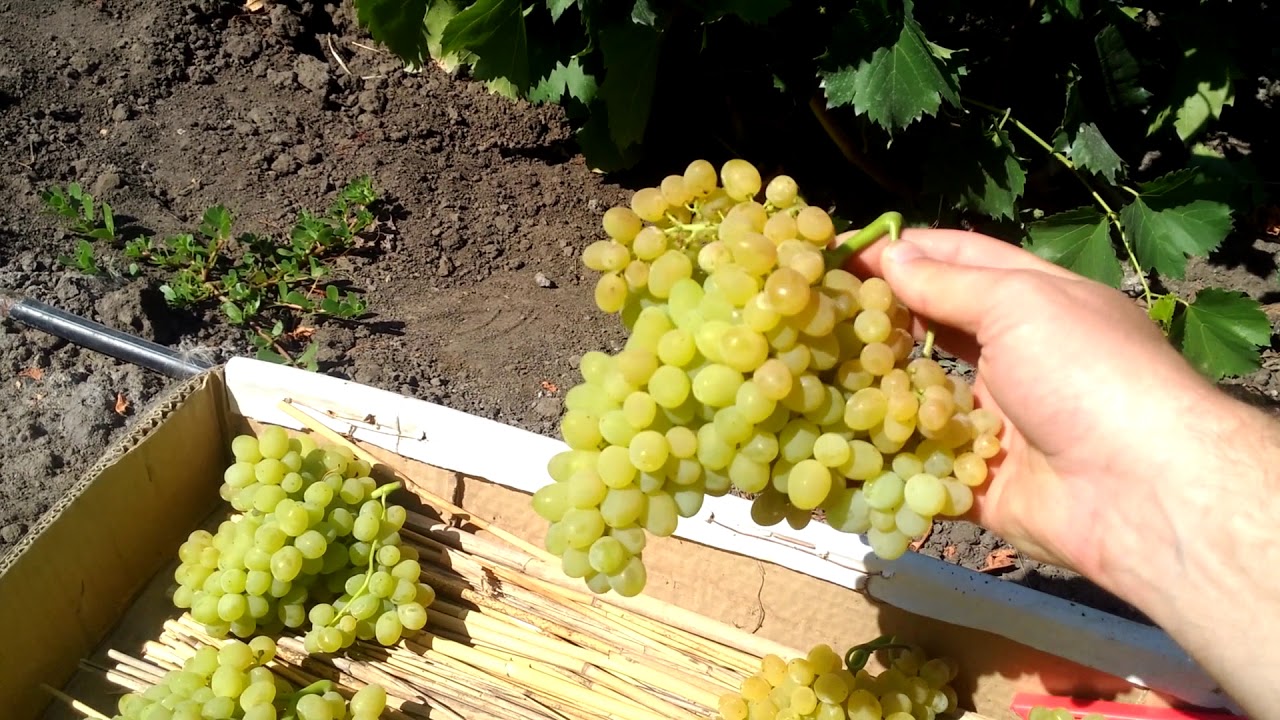
1 comment